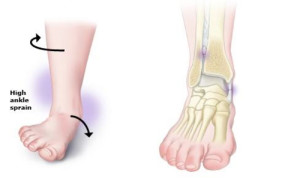
High Ankle Sprains
A high ankle sprains is a term used to describe a sprain of the ligament called the syndesmosis or syndesmotic ligament. This ligament is fairly large and holds the two lower leg bones, the tibia, or shin bone, and the fibula, together. This ligament is most likely torn with an increased external rotation (turned to the outside) at the ankle joint or forced dorsiflexion (the foot pointed up).
Treatment for this condition includes strength, power and endurance exercises as well as flexibility exercises. Gait training and balance, coordination and agility exercises are also provided.
Goals of treatment include:
- Reduction of joint swelling, inflammation, and mobility
- Elimination of pain, improvement of gait
- Improvement of joint integrity and mobility
- Increase in muscle performance (strength, power, endurance)
- Increase in ROM
- Improvement of weight-bearing status
- Overall improvement of health, wellness and fitness
POSSIBLE TREATMENTS MAY BE:
FOR PHASE 1:
- Ice
- Active ankle ROM exercises
- Ankle mobilizations
- Soft tissue massage
- Stationary bike
FOR PHASE 2:
- Encouragement of normal gait
- Hopping, light jogging and maneuvering around obstacles
- Strengthening exercises including resisted ankle ROM with theraband, resisted heel and toe rasies, lunges and squats.
- Single leg stance on the foam pad or mini trampoline.
- At home the patient can use a pillow for the proprioceptive exercises in their home exercise program. Strengthening exercises should be progressed in the home exercise program in this phase as well.
As the single leg stance becomes easy the therapist adds in a ball toss, squats or lunges onto the the foam pad or mini trampoline.
Progression of the strength and proprioception exercises are patient specific.
FOR PHASE 3:
- A focus on getting the patient back to their prior level of function.
- More aggressive strengthening, sport specific drills, jumping rope, leaping, side and backward shuffling should be the focus
- Sport specific drills may include: simulating passing routes for football players or dribbling a soccer ball in straight lines and around obstacles for soccer players or running lay-up drills for basketball players.
USE OF MODALITIES IN ALL 3 PHASES:
The most commonly used and effective modalities are ice and IFC. Ice can be used to help decrease inflammation and pain and is effective throughout rehabilitation.
TENS and IFC have been shown to be effective early on in rehabilitation for pain relief. Acupuncture is very effective for swelling reduction, pain relief and healing.
SPECIAL NOTE: in the beginning of treatment, it is crucial to keep weight off the involved ankle in order to prevent heterotrophic ossification in the interosseous membrane and delay healing.
If the syndesmosis is torn, since it accounts for a large portion of ankle instability, surgery may be indicated. Injury involving the syndesmosis takes twice as long to rehabilitate as a grade III high ankle sprains .
Treatment
Physiotherapy & Chiropractic Treatments include light stretches for the support muscles, Therapeutic Ultrasound, and the use of TENS machine to relieve pain.
Please contact us for different treatment method for high ankle sprains.
